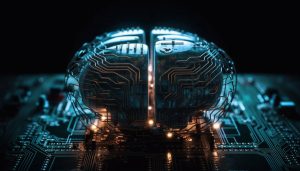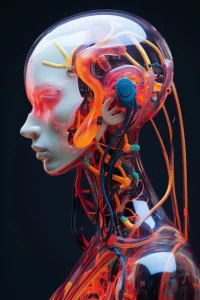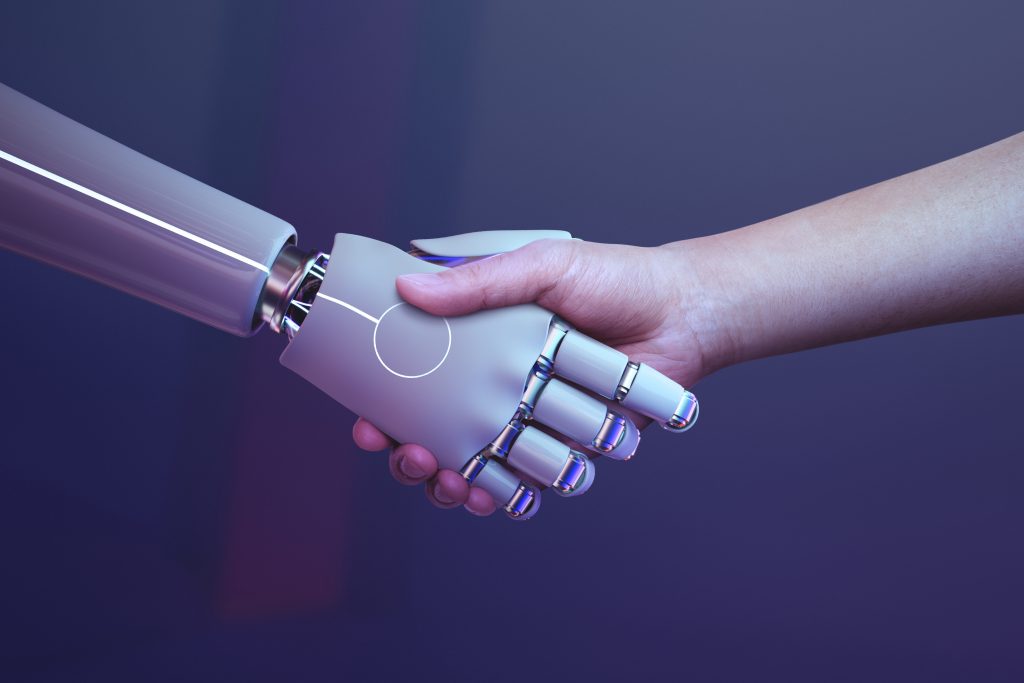Deep Learnig

what is AI // क्या है ai //type of ai
Reinforcement learning- (RL)-What is RL in reinforcement?-introduction
There is a subfield of machine learning that has traditionally focused on creating and training artificial neural networks to perform tasks requiring human intelligence. It is inspired by the structure and function of the human brain, where networks of interconnected neurons process and transmit information. At the heart of deep learning are
neural networks, which are computational models made up of
layers of interconnected nodes (neurons). Each connection between the nodes has an equal weight that is
adjusted during the training process. The network processes input data
through these interconnected layers, gradually learning to recognize
patterns and features in the data. “Depth” in deep learning refers to the use of multiple layers, allowingnetworks to learn increasingly
complex representations of data as it Mgoes deeper into the network.
Deep learning includes some key
concepts and techniques.

Convolutional Neural Networks
(CNN):
These are specialized
neural networks designed to process
grid-like data such as images and
videos. they विजअ
़ु
ल डेटा सेसव
़ु
िधाओं
को स्िचावलत रूप से सीखने और वनकालने
Let’s use the convolutional layers.
TYPE OF WHAT IS DEEP LEARNING
Recurrent Neural Networks
(RNNs)
These networks are
designed to work with a sequence of
data such as text or time series. They
have connections that loop
themselves, allowing them to retain
the memory of previous inputs.
Long short-term memory
(LSTM) and gated
recurrent units (GRUs):
These are special types of
RNNs that are capable of
learning and maintaining
long-term dependencies in
sequences, which makes them
particularly useful for tasks
involving context and memory.
Autoencoders:
These are neural
networks that are used for
unsupervised learning. They learn to
present data in compressed form,
which can be useful for tasks such as
data denoising, dimensionality
reduction, and anomaly detection.
Generative Advisory Network
(GAN): GAN consists of two
neural networks, a generator
and a interpreter, which are
trained together in a competitive
manner. GAN is used to generate
new, synthetic data that resembles a
given training dataset.
Transfer Learning:
It involves
using a pre-trained neural network
on a task and transferring its learned
knowledge to a different but related
task. This is especially useful when
there is limited labeled data for the
new task.
Deep Reinforcement Learning:
This is the integration of deep
learning with reinforcement
learning, where an agent learns to
take action in the environment to
maximize the reward signal. Deep
reinforcement learning has been
used in a variety of applications,
including game play and robotics.
C0NCLUSION
Deep learning has made
remarkable in various
fields including computer
vision, natural language
processing, speech recognition,
etc Success has been achieved. Its
effectiveness is often attributed
directly to the ability to
automatically learn relevant
features and representations from
raw data, Thereby reducing the
need for manual feature
engineering
BEST TYPE WHAT IS DEEP LEARNING
what is AI // क्या है ai //type of ai
Reinforcement learning- (RL)-What is RL in reinforcement?-introduction
FAQ
What is meant by deep learning?
suggestion WHAT IS DEEP LEARNING
Deep learning is like teaching computers to think and learn from examples, similar to how you learn from your experiences. It’s a way for computers to understand and recognize patterns in data, which helps them make decisions or predictions. Just like you get better at something with practice, deep learning algorithms improve as they’re exposed to more and more data. They use artificial neural networks, which are inspired by the human brain, to process information in layers, gradually learning to recognize complex patterns.
What is deep learning and examples?
suggestion WHAT IS DEEP LEARNING
Deep learning is a type of computer technology that helps machines learn from examples. It’s like showing a computer lots of pictures of cats and dogs so it can figure out how to tell them apart. The computer uses special brain-inspired networks to understand these pictures, getting better at telling cats from dogs the more pictures it sees. This technology is used for things like making self-driving cars see and understand the road, helping phones recognize your face, and even suggesting what to watch on streaming services based on what you’ve liked before.
Why it is called deep learning?
suggestion WHAT IS DEEP LEARNING
It’s called “deep learning” because it involves using deep, layered networks of computer components that work together to learn and understand things. Just like when you learn, you start with simple ideas and build up to more complex ones, these networks learn from basic features of data and combine them to understand deeper and more intricate patterns. So, “deep” in “deep learning” refers to the multiple layers of learning that happen in these networks.
What is CNN in deep learning?
suggestion WHAT IS DEEP LEARNING
CNN stands for Convolutional Neural Network. Think of it like a special tool in deep learning that’s really good at understanding pictures. Just like you look at different parts of a picture to understand what’s in it (like eyes, nose, etc.), CNNs break down images into smaller parts and learn to recognize patterns in those parts. This helps them figure out if an image contains things like cats, dogs, or even objects in self-driving cars. So, CNN is like a detective for pictures in the world of computers.
What are the benefits of deep learning?
suggestion WHAT IS DEEP LEARNING
Deep learning helps computers do things that usually need human intelligence. It’s super good at finding patterns in large amounts of data, like images, sounds, and text. This makes it awesome at tasks like:
1. Recognizing Stuff: It can identify what’s in pictures and videos, like telling apart different animals or objects.
2. Understanding Language: It can read and understand human language, which helps in things like chatbots and translators.
3. Predicting Things: It’s great at guessing what might happen next, like predicting weather or stock prices.
4. Driving and Robots: It’s used in self-driving cars and robots to help them see and make decisions.
5. Healthcare: It helps doctors spot diseases from medical images and even suggests treatments.
6. Entertainment: It powers recommendation systems for music, movies, and more.
So, the big benefit is that deep learning makes computers smart in ways that help us in lots of cool and useful ways!
How many layers are there in deep learning?
suggestion WHAT IS DEEP LEARNING
In deep learning, there can be many layers, kind of like stacking building blocks. These layers help computers understand things step by step, starting with simple details and building up to complex ideas. The more layers, the deeper the learning! But, the number of layers can vary a lot based on what the computer is learning to do. Sometimes there are just a few layers, and other times there can be a whole bunch – it depends on the task at hand.
How do I start deep learning?
Starting with deep learning is like learning a new game or hobby. Here’s a simple guide:
1.Learn the Basics: Understand what deep learning is and how it works. You don’t need to know everything at once.
2. Get Comfy with Coding: Learn a programming language like Python. It’s like your tool to talk to the computer.
3. Learn Libraries: Libraries are like ready-to-use tools for deep learning. Popular ones are TensorFlow and PyTorch. They make things easier.
4.Start Small: Begin with simple tutorials. Like making the computer recognize handwritten numbers (digits).
5. Build Step by Step: Gradually take on more complex projects as you get better. Try things like recognizing animals or even making your own chatbot.
6. Online Courses: Join beginner-friendly courses. They guide you through learning deep learning step by step.
7. Practice A Lot: Just like you get better at a game by playing, deep learning improves with practice. Experiment, make mistakes, and learn from them.
8. Learn From Others: Read articles, watch videos, and connect with others who are into deep learning. They can share tips and experiences.
Remember, it’s okay to start small and take your time. Deep learning can be challenging, but it’s rewarding when you see your computer learn and do amazing things!
Is deep learning supervised or unsupervised?
suggestion WHAT IS DEEP LEARNING
Deep learning can be both supervised and unsupervised, like two different ways of learning.
1. Supervised Learning: This is like teaching with examples. You show the computer lots of examples and tell it what each example is. It learns to recognize patterns and can then predict or classify new things.
2. Unsupervised Learning: This is more like letting the computer explore on its own. It looks at the data and tries to find patterns without being told what’s what. It’s like the computer discovering things by itself.
So, deep learning can use either of these ways, depending on what you want the computer to do.
What is deep learning answers?
“Deep Learning Answers” means solutions or results that result from the use of Deep Learning techniques. It’s like when you ask a question or give a task to a computer, and it uses its learning to answer you. These answers can be really accurate and helpful because the computer has learned from a lot of examples and patterns.
What are the two types of deep learning?
suggestion WHAT IS DEEP LEARNING
Supervised Learning: This is when you teach the computer using labeled examples. You show it lots of examples with obvious answers, and it learns to predict answers for new examples.
Unsupervised Learning: Here, the computer searches the data without specific answers. It itself tries to find patterns and relationships, which can help in understanding the data better.
These two types help the computer to learn and understand different types of information.
Where is deep learning used today?
suggestion WHAT IS DEEP LEARNING
Deep learning is used in many places today, making things smarter and more useful:
Phone: This helps to recognize your face or voice to unlock the phone.
Streaming: Suggests shows or music you might like based on what you’ve watched or listened to before.
Health care: It helps doctors analyze medical images like X-rays to diagnose diseases.
Self-driving cars: Deep learning helps cars see the road and make safer decisions.
Translation: It does quick and accurate translation of languages.
Gaming: It powers up smart opponents in video games.
Finance: It predicts stock market trends and helps manage risks.
E-commerce: Recommends products you might want to buy.
Social Media: It detects and removes inappropriate content.
Art: It creates new art and music.
Who is father of deep learning
Geoffrey Hinton is often considered the “father” of deep learning. He is a scientist who played a huge role in developing and popularizing the ideas behind deep learning. As a guide, he helped make deep learning powerful and practical.


